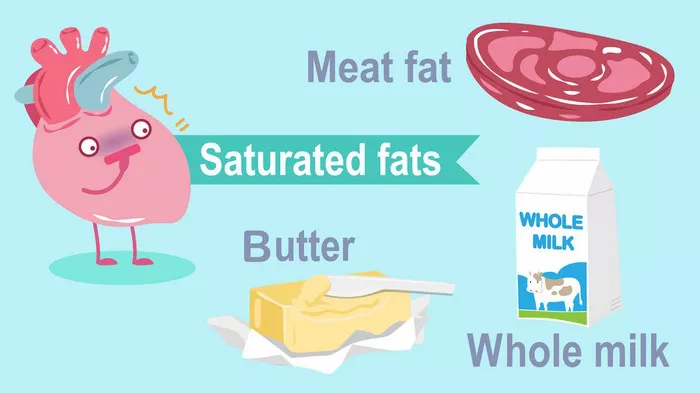Saturated fat has long been a topic of debate and concern in the realm of nutrition and health. From its association with heart disease to its role in weight gain, the impact of saturated fat on our well-being has been extensively studied and discussed. One common question that arises is whether saturated fat can be burned off through exercise and other means. In this article, we delve into the science behind saturated fat metabolism, the effectiveness of exercise in burning off saturated fat, and the myths surrounding this nutrient.
Understanding Saturated Fat
Saturated fat is a type of fat molecule that is typically solid at room temperature. It is found in various foods, including animal products like meat and dairy, as well as in some plant-based oils such as coconut oil and palm oil. Historically, saturated fat has been linked to an increased risk of heart disease due to its ability to raise levels of LDL cholesterol, often referred to as “bad” cholesterol.
However, recent research has challenged some of these assumptions, suggesting that not all saturated fats are equal in their effects on health. For example, some studies have indicated that certain saturated fats, such as those found in dairy products like cheese and yogurt, may not have the same negative impact on heart health as saturated fats from processed meats.
Metabolism of Saturated Fat
When we consume saturated fat, it is broken down in the digestive system into its constituent fatty acids. These fatty acids are then transported to various tissues in the body, where they can be used for energy or stored as fat. The liver plays a crucial role in processing saturated fat, converting excess fatty acids into other compounds or storing them as triglycerides.
Unlike carbohydrates, which are readily converted into energy and used by the body, saturated fat metabolism is more complex and regulated by hormonal and enzymatic processes. This means that simply “burning off” saturated fat through exercise is not as straightforward as it may seem.
Exercise and Saturated Fat
Exercise is often touted as a way to burn off excess fat, including saturated fat. Indeed, physical activity can increase energy expenditure and promote the breakdown of fatty acids for fuel. However, the relationship between exercise and saturated fat metabolism is nuanced.
Research suggests that while exercise can lead to overall fat loss, it may not specifically target saturated fat stores. Instead, the body tends to mobilize fat from various sources, including both saturated and unsaturated fat stores, depending on factors such as exercise intensity, duration, and individual metabolism.
Moreover, the type of exercise matters. Aerobic exercises like running, cycling, and swimming are known to increase fat oxidation and overall calorie expenditure, which can contribute to a reduction in body fat, including saturated fat. Strength training, on the other hand, may not directly impact saturated fat stores but can help increase muscle mass and metabolic rate, leading to long-term fat loss.
Debunking Myths About Saturated Fat
There are several myths surrounding saturated fat and its metabolism that warrant clarification:
1. Myth: All Saturated Fat Is Harmful
Reality: Not all saturated fats have the same impact on health. Some saturated fats, such as those from sources like coconut oil and avocados, may have neutral or even beneficial effects on cholesterol levels when consumed in moderation.
2. Myth: Exercise Alone Can Burn Off Saturated Fat
Reality: While exercise is important for overall health and weight management, it may not specifically target saturated fat stores. A combination of healthy eating habits, regular physical activity, and lifestyle factors is key to managing saturated fat intake and promoting overall well-being.
3. Myth: Saturated Fat Cannot Be Metabolized
Reality: Saturated fat is metabolized in the body through various pathways, including oxidation for energy production and storage as triglycerides. The body has mechanisms to process and utilize saturated fat, although excessive intake can lead to health issues over time.
Strategies for Managing Saturated Fat Intake
To effectively manage saturated fat intake and promote a balanced diet, consider the following strategies:
1. Focus on Whole Foods: Choose whole, minimally processed foods that are naturally low in saturated fat, such as fruits, vegetables, whole grains, lean proteins, and healthy fats like olive oil and nuts.
2. Moderate Saturated Fat Intake: While saturated fat can be part of a healthy diet, it’s essential to consume it in moderation and balance it with unsaturated fats, such as those found in fish, seeds, and avocados.
3. Prioritize Physical Activity: Incorporate a mix of aerobic and strength-training exercises into your routine to support overall health, improve cardiovascular fitness, and promote fat loss.
4. Read Labels: Be mindful of food labels and choose products with lower saturated fat content. Opt for lean cuts of meat, low-fat dairy options, and alternatives to saturated fat-rich ingredients when cooking.
5. Consult with a Healthcare Professional: If you have specific health concerns or dietary needs, seek guidance from a registered dietitian or healthcare provider to develop a personalized nutrition plan.
Conclusion
While the question of whether saturated fat can be burned off through exercise is complex, focusing on a balanced diet, regular physical activity, and overall healthy lifestyle habits is key to managing saturated fat intake and promoting optimal health. By understanding the science behind saturated fat metabolism and debunking common myths, individuals can make informed choices to support their well-being in the long term.


